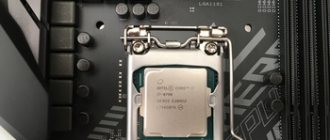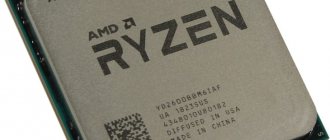No one has monopolized the computer processor market; devices from Intel and AMD are widely represented on it. Their confrontation looks like the struggle of Nanai boys. Before upgrading a computer or buying a laptop again, a person has to trust the seller, a familiar IT professional, or delve deeply into the topic of the differences between Intel and AMD processors. Only if you have complete information will you select a processor that meets your needs without overpaying for the crystal itself and the motherboard.
Let's not praise, denigrate or drown anyone. We conducted a comprehensive analysis of technical, marketing, and operational indicators, without forgetting about the financial component of the issue. If you are faced with a choice: Intel or AMD, carefully read the material, noting for yourself certain features of manufacturers and specific processor lines.
Main differences between processors
Let's start with the features, technological and other differences between the devices of competitors from Silicon Valley, whose headquarters are located next door.
AMD
Nice features:
- Loyal pricing – compared to Intel, processors with similar performance are cheaper: an 8-core processor from Intel and a 12-core processor from AMD of the same generation cost the same.
- Compact, high-performance coolers that allow you to overclock crystals.
- Free software with automatic overclocking function.
- Wide compatibility (including backwards) of motherboards on socket AM4 will allow you to save on the purchase of a motherboard.
- Supports overclocking of motherboards, except A-series.
- Increased speed of the PCIe 4 interface.
- Using solder as a thermal interface.
- The most powerful models include twice as many cores and threads as Intel.
- Higher performance in multi-threading mode: 3D graphics, modeling, visualization.
- For most models, each core processes data in two threads.
- Medium and high performance graphics cores.
- At the same load they consume less electrical energy.
Flaws:
- There are few applications adapted for the AMD architecture.
- Models with 6 or more cores are supplied without integrated graphics. On the one hand, this is a minus - you need a video card, on the other - less heating of the crystal and the calculation that a powerful system does not need weak graphics.
- Weak overclocking potential when loading on multiple cores. Explained by factory overclocking.
- Frequent problems with drivers and BIOS firmware.
CPUs from AMD are ahead of competitors' devices in technical terms (lithography), but they are produced at foreign production facilities.
Intel
Nice features:
- They are predominantly the first to introduce new technologies.
- Demonstrates better performance in single-threaded mode - suitable for video games.
- By overpaying for a high-quality motherboard and smart cooling, you will get systems with high overclocking potential.
- They are not demanding on RAM - their performance on RAM at different frequencies differs less than in AMD.
Flaws:
- Cheap cooling systems with primitive mounting designs that often break. Standard coolers do not always cope with heat dissipation.
- Overclocking is not provided on B- or H-series motherboards; to unlock the potential of the crystal, you need a premium Z-series motherboard.
- The PCIe 3 bus, which has half the speed of PCIe 4, is widely used.
- Even expensive models are cooled using thermal paste; for some reason, solder is the preserve of a select few.
- They are generally more expensive than competitor's analogues.
- Low and medium performance graphics cores.
- Frequent changes of sockets, which means replacing the motherboard when upgrading the system.
Process and architecture
To simplify, here you can follow a simple rule: the newer, the better. For example, the once top-end Intel Core i7 Haswell i7-4770K Price from 16,990 to 17,990 rubles. the fourth generation now shows almost the same performance as the budget Intel Core i3 Coffee Lake i3-8100 BOX Price from 14,635 to 14,789 rubles. eighth generation.
Intel has the most current line at the moment, Coffee Lake Refresh. As the name suggests, this is essentially a cosmetic update to the previous Coffe Lake series, only with slightly increased clock speeds and better prices. You can see an overview of the most interesting processors in this series in the article “Coffee Lake Refresh Revision: Which Intel Processor to Choose in 2021.” AMD recently debuted a completely new Zen 2 architecture (read about it in the article “Comparison of AMD X470 and X570 chipsets, what’s new?”), on the basis of which the company managed to introduce the first mass processors with 12 and 16 cores - AMD Ryzen 9 Matisse 3900X BOX Price from 33,050 to 46,912 rubles. and AMD Ryzen 9 Matisse 3950X BOX Price from 54,200 to 65,000 rubles. However, the previous generation of Ryzen is still setting the heat and works on simpler and cheaper motherboards.
Key Difference Between AMD and Intel
Over the past 10 years, AMD has been labeled as "cheap and cheerful", while Intel has been associated with high quality and performance. After the release of breakthrough Ryzen processors, the situation changed: AMD was no longer associated with cheapness and poor performance, and Intel received a magical kickback, which forced it to look for new strategies and reduce prices.
The lines have blurred in 2021, but a quick glance around still reveals one key difference. As a rule, Intel relies on higher nominal frequencies, while AMD attracts potential buyers with the number of cores and multi-threading. As sales show, there are much more people willing to vote in rubles for the second option. From the October 2021 report from the largest German online store MindFactory.de, we can see that Ryzen CPUs sell almost 4 times more than Intel - 78% versus 22%. But this does not mean that AMD is cooler than Intel and we can disagree. Both companies have their strengths and weaknesses, as well as hit models and downright unsuccessful processors.
Gaming performance comparison
As the review and tests show, the differences between modern CPU models from competing companies are no longer so significant. Intel is still the king of gaming systems, but its dominance is not as significant. With top-end GTX 1080 Ti graphics cards, top-end Intel processors like the i7-8700K provide better performance in most modern games. In the future, it is possible that the situation will change in favor of AMD processors with a higher number of threads due to improved multithreading support in new games.
When comparing average FPS at Ultra graphics settings and FullHD resolution, Intel processors are on average 10% faster than their direct competitors from AMD. However, the size of the gap depends on the game itself. For example, in Shadow of the Tomb Raider Intel Core i9 Coffee Lake Refresh i9-9900K BOX Price from 31,570 to 36,505 rubles. produces an average of 17 FPS more than the AMD Ryzen 9 Matisse 3900X BOX Price from 33,050 to 46,912 rubles. - 131 FPS versus 114 FPS. But in Assassin's Creed Odyssey, the gap, on the contrary, is reduced to a paltry 4 FPS. However, the 9900K can be found on sale for almost $100 cheaper than the 3900X.
So is Intel still the king of gaming? Not really. In terms of dollar-to-FPS ratio (note: price-to-performance ratio), AMD CPUs are in the lead in most cases. Below you can see a comparison table that summarizes the average frames per second of 8 popular games in 2021, as well as how much dollars one FPS costs.
As you can see, out of 11 models, there are only 3 Intel processors in the top. The remaining 8 are representatives of the “red” camp. Moreover, budget models like AMD Ryzen 5 Summit Ridge 1600 BOX 14 nm Price from 10,231 to 11,620 rubles, and high-performance CPUs of the caliber AMD Ryzen 7 Pinnacle Ridge 2700X BOX turn out to be profitable. In general, the unspoken rule “Intel is more expensive and faster in games” is confirmed again. But the gap is completely insignificant.
Performance comparison at work
And this is where the fun begins. The fact is that Intel has been confidently leaving AMD behind for a long time both in games and in work applications. And if you looked into the work PC of a famous music producer, a seasoned video editor or an experienced graphics specialist, then with a 99% probability you would see a powerful Core i7 or Core i9. Intel chips have become synonymous with fast and reliable operation - Apple and other PC and laptop manufacturers use only them, and specialized software manufacturers Steinberg, Adobe, Ableton, Output, or Waves optimize their software with Intel in mind.
In 2021, the situation has become much more confusing. With more cores and threads (at the same price), processors like the Ryzen 3600X have more headroom than Intel CPUs of the same caliber. But due to software optimization for Intel, this difference is not always fully realized. For example, in plug-in loading tests in Reaper, identical chips from Intel outperform competitors from AMD by almost 30%.
In the table below you can see the general results of the synthetic test SYSmark 2021. They are worth taking seriously because what is considered here is not conditional “parrots”, but system performance when executing various user scenarios such as working in Acrobat Pro, Photoshop, BowPad, Excel or PowerPoint. As you can see, the new processors with the Zen 2 microarchitecture have noticeably improved their results - while a year ago the eight-core Ryzen 7 2700X in SYSmark 2018 was far short of modern Core i5 processors, the new six-core Ryzen 5 3600X and Ryzen 5 3600 confidently outperform its direct competitor in the six-core Core i5 and are almost overtaking the higher-end Core i7-8700K, which costs $150 more.
What’s even more interesting is that this picture is observed in any test that simulates everyday work with content, rendering, complex calculations, etc. Apparently, such a breakthrough happened due to the fact that AMD implemented in Zen 2 full execution of AVX2 instructions and L3 doubled in size -cache. If we compare with previous generations, the performance of the new six-core AMD relative to the Ryzen 5 2600X has increased by an average of 20% and reached the level of the eight-core Ryzen 7 1800X of the generation before last. Impressive result!
How else do Intel and AMD processors differ?
Which is better for games: Intel and AMD
AMD is closing the gap in gaming performance - in single-threaded load mode, but the lag behind Intel is still noticeable. On the other hand, to demonstrate Intel's superiority, you need a high-performance video card and a gaming monitor, especially with a resolution above 1080. AMD is better suited if, during gameplay, the processor is working in the background on other tasks - streaming, converting, visualization, supporting dozens of applications.
Intel is better exclusively for gaming, but few people use a PC purely for 3D entertainment. Plus: the difference between powerful CPUs is not so significant as to overpay for single-threaded performance, and in games the main role is assigned to the video card.
A few words about Xeon
Xeons are produced using the 14-nm process technology, but with improvements that increase the Boost frequency by 200-300 MHz and the second-level cache size to 55 MB. The crystals operate with memory up to 2400 MHz and accommodate up to 22 physical cores versus 64 for AMD. AVX2 technology improves performance and data encryption with optimized keys enhances system security.
On the other hand, for every 20-core Xeon, there is more than one defective one with all that it entails. Despite all the efforts of engineers, the situation has not changed noticeably.
In terms of price/performance ratio, assemblies on used Zions with Chinese motherboards and not the latest RAM are many times greater than what you can buy in a store today.
Among the minuses, we note increased power consumption with heat dissipation, as well as a small selection of motherboards and the low quality of some of them.
Rating of the TOP 10 best Ryzen processors
Having carefully analyzed the market for products of this type, we have compiled the corresponding most objective rating:
- AMD Ryzen 5 3600.
- AMD Ryzen Threadripper Colfax.
- AMD Ryzen 5 2600.
- AMD Ryzen 9 3900X.
- AMD Ryzen 9 3950X.
- AMD Ryzen Threadripper.
- AMD Ryzen 7 2700X.
- AMD Ryzen 5 3400G.
- AMD Ryzen 5 2400G.
- AMD Ryzen 7 3700X.
Let us consider each of the presented models in more detail, paying attention to individual technical parameters.
AMD Ryzen 5 3600
The AMD Ryzen 5 3600 processor is a powerful solution from one of the two world leaders in the production of technological solutions. The model, produced on the basis of Zen 2 architecture and 7 nm process technology, has 6 cores. The L3 cache capacity is an incredible 32 MB. The processor frequency, the base value of which is 3600 MHz, can be increased to 4200 MHz in turbo mode.
The device does not have a built-in graphics core. This is justified, because such a powerful processor clearly needs a video adapter of the appropriate level. The maximum amount of memory compatible with the device is 128 GB. The memory can operate at frequencies that vary widely - from 1600 to 3200 MHz. The processor supports Pure Power energy-saving technology and has low power consumption. The model is characterized by a TDP of 65 W.
| Technical process | 7 nm |
| Frequency | 3600 MHz |
| Number of threads | 12 |
| Number of Cores | 6 |
Price: from 15,065 to 18,812 rubles.
AMD Ryzen 5 3600
Advantages
- highly efficient Pure Power energy saving technology;
- a standardized set of instructions and commands;
- unique technology for increasing frequency Precision Boost 2.
Flaws
- not found.
The Ryzen 3600 processor was purchased a year ago in the DNS store and, based on those realities, its parameters completely satisfied me; in fact, now I don’t notice any problems with performance either - the processor in conjunction with the GTX 1660 easily copes with any (even the most “heavy”) games and programs. I don’t want to tell you anything about the architecture, component base and other scientific things, so I’ll say it briefly and clearly - for its money, AMD’s product really performs well and “butts heads” with its competitors with dignity.
AMD Ryzen Threadripper Colfax
The incredibly powerful Threadripper Colfax processor has sixteen cores on board with a base clock speed of 3500 MHz, which increases to 4400 MHz when operating in turbo mode. Modern Precision Boost 2 technology is responsible for increasing these numerical parameters.
Such a CPU will be a good solution for the productive home station you are building or a computer with gaming capabilities. It supports operation with DDR4 RAM, which has a clock frequency in the range of 1600-2933 MHz, and the largest supported amount of RAM is 256 GB.
| Technical process | 12 nm |
| Frequency | 3500 MHz |
| Number of cores | 16 |
| Number of threads | 32 |
Price: from 59,103 to 66,664 rubles.
AMD Ryzen Threadripper Colfax
Advantages
- high maximum frequencies (up to 4.4 GHz);
- a lot of cache memory (32 MB at all levels);
- unlocked multiplier.
Flaws
- large TDP of 180 W.
After the release of the stable Ryzen line, all people began to suddenly switch to them, because they know about the high service life of the product. Indeed, this model is equipped with a reliable metal case, excellent crystal and nanochip protection, a stylish packaging box design and incredibly high performance. Finding something significantly better and more stable nowadays is quite difficult and you will probably have to look at competitors.
AMD Ryzen 5 2600
The Ryzen 5 2600 processor (standard OEM version) delivers best-in-class performance that will meet the needs of most gamers and developers. It is equipped with six cores that process requests at a frequency of 3400 MHz in base mode and 3900 MHz in turbo mode. The maximum possible number of threads is 12 pieces.
The third level cache is 16 MB, which is absolutely enough for almost any task. The product is designed to work with the latest DDR4 memory standard, and the maximum frequency of the dies can be up to 2933 MHz. Thanks to the advanced energy-saving technology Pure Power, the developers managed to reduce heat dissipation to 65 W. AMD StoreMI technology is a powerful tool designed to speed up computer and program startup times, improve file management, and improve system responsiveness.
| Technical process | 12 nm |
| Number of cores | 6 |
| Clock frequency | 3400 MHz |
| Number of threads | 12 |
Price: from 9,884 to 11,054 rubles.
AMD Ryzen 5 2600
Advantages
- low power consumption (65 W);
- instant data caching;
- exclusion of invalid component signals.
Flaws
- not found.
One of the reasons why AMD Ryzen processors always attract so much attention from consumers lies in the pricing policy, which is formed in such a way that offers from Intel are not the best in terms of price-quality ratio. Strictly speaking, this processor is a stable budget processor with incredibly high overclocking potential and good factory specifications. At the same time, the product “eats” a little and does not require massive cooling.
AMD Ryzen 9 3900X
Blur the line between elite gaming performance and content creation workstation with the world's most advanced desktop processors. AMD's high-performance x86 Zen 2 core architecture enables Ryzen 9 3900X processors to deliver higher single- and multi-threaded performance than any other processor. Essential to the success of gamers and content creators, this performance helps them win everywhere, every time. The model is designed with a focus on premium users and offers a new innovative design of twelve cores based on Matisse core development technology.
You will be interested in: TOP 13 best stabilizer for a phone: rating, which one to choose and buy, characteristics, reviews, pros and cons
| Number of cores | 12 |
| Frequency | 3800 MHz |
| Technical process | 7 nm |
| Number of threads | 24 |
Price: from 35,906 to 39,224 rubles.
AMD Ryzen 9 3900X
Advantages
- there is cooling included;
- support for 64-bit command set;
- virtualization technology emulates the operation of several computers on one system unit.
Flaws
- not found.
A really good processor, you definitely can’t call it a budget processor, but it’s more than worth the investment. Heat dissipation has been increased compared to the previous model, and against this background, the Wraith Prism with RGB LED overheating protection system has appeared, which reduces the risk of overheating to a minimum threshold. In general, the product feels like it works one hundred percent and copes well with any task at all, turning the work process into real pleasure and some kind of relaxation.
AMD Ryzen 9 3950X
The flagship processor, created on the basis of the Matisse architecture, has increased the number of cores to 16, the device is capable of solving any task. It blurs the lines between high-performance gaming and productivity for confident PC users. Manufacturers have managed to achieve high energy efficiency of the device. As a result, this processor performs well in the entire range of existing tasks and under maximum loads.
Compared to multi-core competitors of the previous generation, it has a completely monolithic design, in which acceptable delays in working with memory, as well as in data exchange, are evenly distributed. Many gamers are now broadcasting game mode, as a result of which they choose a suitable processor for this, for example, the Ryzen 9 3950X.
| Technical process | 7 nm |
| Frequency | 3500 MHz |
| Number of cores | 16 |
| Number of threads | 32 |
Price: from 58,967 to 66,943 rubles.
AMD Ryzen 9 3950X
Advantages
- low heat losses;
- large third level cache (64 MB);
- free 35x multiplier.
Flaws
- not detected.
In terms of topology, the new 16-core Ryzen 9 3950X is very similar to the Ryzen 9 3900X I previously reviewed. Before us is the second mass-produced AMD processor, based not on two, but on three semiconductor crystals, called chiplets in modern terminology. In order not to burden you with theory, I will say briefly and as clearly as possible - the processor is expensive, but it is really powerful and efficient in terms of peak performance, I recommend it.
AMD Ryzen Threadripper
The Threadripper BOX version is one of the most powerful CPUs for desktop computers, with 32 cores and support for 64 threads. It supports a base clock speed of 3000 MHz and can be increased with Precision Boost 2 technology, which allows you to raise the clock speed to an incredible 4200 MHz. The device is characterized by compatibility with the latest DDR4 RAM, its clock frequency is in the range of 1600-2933 MHz. It also supports up to 256 GB of RAM.
| Technical process | 12 nm |
| Frequency | 3000 MHz |
| Number of cores | 32 |
| Number of threads | 64 |
Price: from 120,430 to 137,076 rubles.
AMD Ryzen Threadripper
Advantages
- 32 cores and 64 threads;
- 64 MB last level cache;
- multi-functional working chip.
Flaws
- will require massive water cooling (TDP = 250 W).
Not a bad choice, it will definitely not go unnoticed by gamers and professional programmers, as well as YouTubers. And in general, people who need the most powerful computer at the moment will clearly choose this option when choosing a processor. It is stable, high-quality, reliable and generally the best Ryzen processor on the market nowadays. Having bought it for myself and used it thoroughly, I could not find any shortcomings - an ideal processor, created for true computer gourmets.
AMD Ryzen 7 2700X
The Ryzen 7 2700X processor is equipped with an AM4 connection connector and is designed for use in a high-performance gaming system unit. The eight-core model with support for sixteen threads has a base clock speed of 3700 MHz and supports Precision Boost 2 overclocking technology, so the frequency can be increased to 4300 MHz.
The CPU is designed to work with DDR4 memory, the frequency of which is in the range of 1600-2933 MHz. The largest amount of RAM supported by this model is 128 GB. The thermal power generated by the processor reaches 105 W, and its highest temperature during operation is 85°C. The device comes with an efficient cooler, so you don't have to choose the appropriate heat dissipation system yourself.
You will be interested in: TOP 10 best wireless keyboard and mouse: rating, which set to choose, reviews, characteristics, pros and cons
| Technical process | 12 nm |
| Frequency | 3700 MHz |
| Cores | 8 |
| Number of threads | 16 |
Price: from 13,023 to 15,054 rubles.
AMD Ryzen 7 2700X
Advantages
- 24 PCI Express lanes;
- efficient energy saving;
- thick metal semiconductor body.
Flaws
- not found.
I would like to start by saying that I don’t particularly understand computers, so I “created” my first computer assembly, one might say, on the advice of friends. I can’t say that it turned out bad (I only made a mistake in the video card, I took one that was too weak). I am very pleased with my new PC, it not only works quickly in any 3D programs and video editing, but you can also play various dynamic games like shooters with it.
AMD Ryzen 5 3400G
Based on the Zen+ architecture, the Ryzen 5 3400G processor is a powerful solution suitable for gaming systems and other personal computers that provide high levels of performance. The model, which has as many as four cores, has a total cache memory of the second and third levels equal to 6 MB. In turbo mode, the processor frequency increases to 4200 MHz, while the device is equipped with a free multiplier.
It is also equipped with an integrated Radeon Vega 11 graphics core, the maximum frequency is 1400 MHz. The processor package includes a cooler; its parameters are calculated down to the smallest detail by AMD specialists. The box, which acts as packaging for the processor, has an attractive appearance.
| Technical process | 12 nm |
| Frequency | 3700 MHz |
| Cores | 4 |
| Streams | 8 |
Price: from 9,965 to 11,054 rubles.
AMD Ryzen 5 3400G
Advantages
- integrated graphics core (Vega 11);
- support for a full set of 64-bit instructions;
- technology of internal and external virtualization.
Flaws
- not found.
Architecturally, Picasso desktop processors (including the Ryzen 5 3400G and Ryzen 3 3200G processor) are based on the same ideas and principles as the Raven Ridge processors. If you don’t go into details, you can put an equal sign between the first and second generations of APUs in the Ryzen lineup. In other words, the differences brought to the Ryzen 5 3400G and the AMD Ryzen 3 3200G Zen+ microarchitecture are quite minor. The difference in specific performance and IPC is about 3%, so many users don’t see much of a difference, but I’m leaning towards this model due to its cost-effectiveness and innovation.
AMD Ryzen 5 2400G
The quad-core Ryzen 5 2400G BOX is an excellent budget option. The model, manufactured using a 14-nanometer process technology, is characterized by a base frequency of 3600 MHz. A free multiplier will allow you to realize the full overclocking potential of the product. One of its advantages is the presence of integrated Radeon Vega 11 graphics.
The maximum frequency of this GPU is impressive: it is 1250 MHz. The device is compatible with DDR4 RAM, which can operate at frequencies from 1600 to 2933 MHz. The cooler parameters are chosen ideally: the temperature of the processor will meet all standards, and the heat dissipation of the device will not exceed 65 Watts.
| Number of cores | 4 |
| Frequency | 3600 MHz |
| Technical process | 14 nm |
| Number of threads | 8 |
Price: from 10,129 to 11,965 rubles.
AMD Ryzen 5 2400G
Advantages
- Raven Ridge innovative cores;
- technology for increasing the standard frequency Boost Precision;
- integrated graphics (Vega 11).
Flaws
- low chip overclocking potential (only 300 MHz).
Recently there was a need to replace the processor with another one, since the old one failed due to improper installation. The choice immediately fell on AMD products, because the main criteria were budget and quality. This product fully meets all my requirements and provides great performance potential. I will also note the presence, although not the most powerful, of a fairly good cooling element (included in the kit).
AMD Ryzen 7 3700X
The Ryzen 7 3700X processor has as many as eight cores built into it. They provide high system performance, allowing you to run several resource-intensive applications at once and not worry about them freezing or closing at the most inopportune moment. The device can be installed in a gaming computer or created from it into an office assembly that works with a large amount of data.
The product supports Turbo mode, when launched, the operating frequency of the processor increases to 4.4 GHz. Due to this, the power of the entire system increases. The model is compatible with dual-channel DDR4 RAM (maximum 128 GB).
| Technical process | 7 nm |
| Number of cores | 8 |
| Frequency | 3600 MHz |
| Number of threads | 16 |
Price: from 22,043 to 24,951 rubles.
AMD Ryzen 7 3700X
Advantages
- The set includes a branded cooler of the brand;
- multi-profile video memory chips;
- high performance in various benchmarks.
Flaws
- not found.
I purchased this processor in January 2021. I was choosing between Intel and AMD for a long time, but after a deeper comparison and advice from friends, the choice was obvious. The price of AMD is significantly lower, while the third level cache is twice as large, and the technical process is the same amount of times smaller. I was impressed by the number of threads and cores working in a single computer “organism”. In general, I’m very pleased with the choice, and I confidently recommend that you buy it in order to enjoy the innovative technologies of the well-known company AMD.
AMD or Intel: which is better for a laptop
Features of the mobile platform are energy efficiency. Tests and comparisons of mobile crystals from both manufacturers show less difference in price and performance than desktop versions. And it is within 2-3, less often – 5% with rare exceptions. Another thing is that most laptops come with Intel processors. The latter are still produced primarily using the 14 nm process technology, gradually moving to 10 nm, with a maximum of four cores. AMD is churning out 7nm chips at full speed.
Integrated Graphics
There are times when the system needs to do without a video card or “sit out” on the integrated graphics before purchasing a discrete one. This option is quite real, especially if you are not an avid gamer. Intel processors, with the exception of top models, have an integrated Intel UHD Graphics video core. Its performance is not as good as that of competitors, but it is quite enough for 4K image output, hardware video decoding, browsing and undemanding tasks.
At the same time, AMD processors with integrated Vega graphics have set a high bar: they cope well with not too power-hungry multiplayer games like Dota 2, World of Tanks, CS:GO and Fortnite, delivering 50 - 60 FPS in FullHD resolution and medium graphics settings. What's even cooler is that Vega 8 became the first integrated video card that runs GTA 5 and The Witcher 3 at minimum settings. Overall, the performance here is almost at the level of the GT 1030 and is far ahead of the integrated graphics in Intel processors.
Conclusion
From all that has been said, you may get the impression that AMD is better than Intel in everything (integrated graphics, number of cores + multi-threading, price), but in fact this is a debate from the category of rap versus rock and a lot depends on personal preferences. For example, integrated graphics are more useful for a budget or office PC that does not have a discrete video card. If you have it, then there’s no point in overpaying for Vega or Intel UHD. Multithreading drags in heavy applications, but in games it has virtually no effect on FPS.
Therefore, it all comes down to price. And guess what? The situation here is also ambiguous. It used to be: Intel is expensive and powerful, AMD is cheap and cheerful. But Ryzen chips have changed everything, AMD is no longer dumping like a desperate, and Intel, under the pressure of competition, is significantly reducing prices. Especially for inexpensive processors. Therefore, the latest generation Core i3 and Core i5, for the most part, feel great in the entry-level and mid-price segment. For example, the new Core i3-9100F looks like perhaps the most interesting option under $100.
But the top-end Core i7 and Core i9 are now inferior to the new Ryzen Matisse in terms of price and performance. The Core i9 is having a particularly hard time: at the end of 2021, AMD will release the first 16-core Ryzen 3950X processor, which will tear apart in heavy applications. And all this for a price of $750. There will be nothing left to justify the draconian prices for Intel's top multi-core processors.
Also, when choosing, it is important to look not only at the price of the processor, but also at the cost of the entire platform in the assembly: processor + motherboard + RAM. And if in the budget segment the spread is not so strong, then for top-end processors the price imbalance does not benefit Intel.
Considering all of the above, for inexpensive assemblies we would proceed from personal preferences, for powerful gaming PCs we would take something like Intel Core i7 Coffee Lake Refresh i7-9700K BOX Price from 20,060 to 31,890 rubles, and for productive workstations we looked I would like AMD Ryzen 7 Matisse 3800X BOX Price from 24,790 to 33,500 rubles. and higher.
Intel monoliths vs AMD chiplets
Monoliths are a two-dimensional arrangement of elements on one physical chip. Monoliths reduce access delays and increase data transfer speeds. Their disadvantage is the cost of producing a CPU with 6 or more cores, increased latency, and bandwidth limitations where they should not exist. Also, each core is a separate component of the crystal that must communicate with others, which is difficult to implement. Hence the increase in the percentage of defects, and hence the cost of production. One or a couple of non-working cores usually send the entire chip to waste.
Chiplets are combined multilayer crystals with CPU, GPU cores, memory and controllers. They are represented by ordered clusters of four cores and their caches - called CCX. They, in turn, are combined into CCD structures - forming the basis of the processor. The solution eliminates the failure of the cluster if the cores in it are not working, for example, with one (the second can be disabled) or two non-working cores, an 8-core processor can be turned into a 6-core processor at a reduced cost.
Chiplets allow you to combine processor, graphics cores, memory and cache memory on one chip, and they can be manufactured using various technological processes.
Sunny Cove vs Zen 2 and Zen 3
The main differences between the Sunny Cove family and Zen:
- Supports AVX-512 instructions, while Zen 2 only works with AVX-256 but performs a couple of operations per clock.
- Using a standard scheduler to process numbers. AMD has separate schedulers for integer and floating point numbers.
- 4 blocks for arithmetic instructions with a bandwidth of 128 bits, in Zen - increased load-store and cache bandwidth.
Zen 2 and Zen 3 improve energy efficiency with new technologies that dynamically control core frequency and voltage based on current load and temperature. EPYC processors now have the option to linearly control the power consumption of each core.
Comparison table between Intel and AMD processors
In terms of technical characteristics, the processors are more or less the same, but AMD’s prices are more affordable.
| AMD | Intel | |
| Price | + | |
| Gaming performance | + | |
| Overall Performance | + | |
| Characteristics | + | + |
| Overclocking | + | |
| Energy consumption | + | |
| Application adaptation | + | |
| Technical process | + | |
| Architecture | + | |
| Safety | + | |
| Multithreading | + | |
| Single threading | + | |
| Equipment | + | |
| Upgrade cost | + | |
| Integrated Graphics 1 | + | |
| Cooling 2 | + |
- AMD with 6 or more cores does not have integrated graphics
- Some AMD Ryzen models have cooling problems, like most blue processors.
Frequency
Everything is simple here: the higher the maximum frequency, the more productive the CPU (note: central processing unit). If you need performance in games and heavy applications, we recommend targeting the 3.5 GHz limit. This is the figure you will see in the minimum system requirements of new games like Red Dead Redemption 2 and Outer World. Although, for games, the performance of the video card will still be more important. Usually Intel processors were ahead here, but now the situation is approximately equal.
What about safety?
Some people initially make secure processors, others implement patches.
- Vulnerabilities . Intel has more than 240 detected vulnerabilities versus AMD’s 16—a 15-fold advantage.
- Performance - Problems were found everywhere, but Intel's solutions slowed down computers up to 5 times more than similar solutions from competitors.
- Software features – Ryzen has implemented SEV – virtual machine memory protection and SME – memory encryption. With the release of Xeon, Intel was only able to respond with TME - total memory encryption.
- Microarchitecture . AMD has few problems and they are not critical at the architectural level, so the company mostly ignores the problems. Intel has many more vulnerabilities, and they are more serious. Engineers have fixed a lot, but many shortcomings remain unresolved.
So far the victory is for AMD.
Processor comparison table
To more clearly compare the models presented above, we use a comparative table of characteristics.
| Model | Process technology (nm) | Frequency (MHz) | Cores | Streams | Price, rub) |
| Ryzen 5 3600 | 7 | 3600 | 6 | 12 | from 15,065 to 18,812 |
| Ryzen Threadripper Colfax | 12 | 3500 | 16 | 32 | from 59,103 to 66,664 |
| Ryzen 5 2600 | 12 | 3400 | 6 | 12 | from 9,884 to 11,054 |
| Ryzen 9 3900X | 7 | 3800 | 12 | 24 | from 35,906 to 39,224 |
| Ryzen 9 3950X | 7 | 3500 | 16 | 32 | from 58,967 to 66,943 |
| Ryzen Threadripper | 12 | 3000 | 32 | 64 | from 120 430 to 137 076 |
| Ryzen 7 2700X | 12 | 3700 | 8 | 16 | from 13,023 to 15,054 |
| Ryzen 5 3400G | 12 | 3700 | 4 | 8 | from 9,965 to 11,054 |
| Ryzen 5 2400G | 14 | 3600 | 4 | 8 | from 10,129 to 11,965 |
| Ryzen 7 3700X | 7 | 3600 | 8 | 16 | from 22,043 to 24,951 |
You will be interested in: Rating of the TOP 10 best intel processors: which one to buy, reviews, price, characteristics, advantages and disadvantages
Price policy
High cost is a weighty argument for almost any choice. And the scales are on AMD's side. Intel hasn’t been able to do anything about this yet: an 8-core “blue” processor costs almost as much as a 12-core “red” one.
Upgrade . When changing a CPU from AMD, you won’t have to spend money on a motherboard; when replacing an Intel one, spending is most likely inevitable.
Cooling . The Reds supply products with a high-quality cooler and often use solder as a thermal interface. The cooling of the “blue” ones is not always enough for effective heat transfer under load; they prefer thermal paste. Sometimes supplied without a radiator with a fan.
Graphic arts . In AMD it is more powerful, but if you choose a 6-core processor and a more powerful CPU, you will have to buy a discrete video card.











